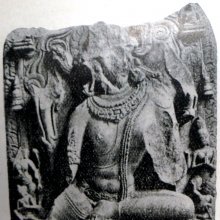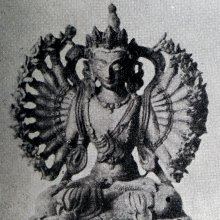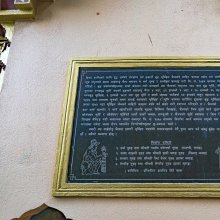Palasha, Palāśa, Palāsa, Palasa, Palāśā, Pālāśa, Pala-asha: 48 definitions
Introduction:
Palasha means something in Buddhism, Pali, Hinduism, Sanskrit, Jainism, Prakrit, the history of ancient India, Marathi, Hindi, biology. If you want to know the exact meaning, history, etymology or English translation of this term then check out the descriptions on this page. Add your comment or reference to a book if you want to contribute to this summary article.
Palasha has 46 English definitions available.
The Sanskrit terms Palāśa and Palāśā and Pālāśa can be transliterated into English as Palasa or Palasha, using the IAST transliteration scheme (?).
Alternative spellings of this word include Plash.
Images (photo gallery)
Languages of India and abroad
Sanskrit dictionary
[Deutsch Wörterbuch]
Source: Cologne Digital Sanskrit Dictionaries: Böhtlingk and Roth Grosses Petersburger WörterbuchPalasa (पलस):—m. = panasa Brodfruchtbaum [Scholiast] zu [Amarakoṣa im Śabdakalpadruma] (u. kaṇṭakiphala). [Rāmāyaṇa 3, 76, 3] (wohl nur fehlerhaft).
--- OR ---
Palāśa (पलाश):—
1) n. Blatt, Laub [Amarakoṣa 2, 4, 1, 14.] [Hemacandra’s Abhidhānacintāmaṇi 1123.] [Anekārthasaṃgraha 3, 723. fg.] (lies palāśaṃ pattre). [Medinīkoṣa śeṣa (s. II.). 23.] [Halāyudha 2, 30.] [The Śatapathabrāhmaṇa 1, 5, 4, 5. 5, 2, 1, 17. 14, 9, 3, 15.] śamī [2, 5, 2, 12.] palāśasya palāśena [6, 2, 8.] anuvṛtaḥ palāśairā mūlāt [Śāṅkhāyana’s Brāhmaṇa 10, 2.] puṭa [Kātyāyana’s Śrautasūtrāṇi 16, 6, 26. -] [ĀŚV. GṚHY. 1, 12.] [Kauśika’s Sūtra zum Atuarvaveda 42. 47. 48. 116.] mālāṃ saptapalāśīm [38.] [Rāmāyaṇa 2, 59, 9.] [Suśruta 1, 108, 9.] [Spr. 638.] śākhāpuṣpapalāśavān [Mahābhārata 3, 1400.] Blüthenblatt: puṣkarapalāśa [LĀṬY. 1, 5, 8.] [Chāndogyopaniṣad 4, 14, 3.] nālatāḍanavibhraṣṭaṃ palāśaṃ (collect.) nalinādiva [Mahābhārata 7, 1299.] padmapalāśākṣa [1, 6399.] [Harivaṃśa 4323.] [Rāmāyaṇa 1, 15, 2. 2, 99, 6.] [Rājataraṅgiṇī 4, 436.] [Bhāgavatapurāṇa 3, 19, 7.] puṇḍarīkapalāśākṣa [Rāmāyaṇa 2, 87, 3.] palāśapattra ein einzelnes Blatt: palāśapattrārdhamapi tvayājito na pārijātasya tava pradāsyati [Harivaṃśa 7334]; dagegen [Śihlana’s Śāntiśataka 4, 11] und [Pañcatantra 245, 14] ein Blatt der Butea frondosa. Vgl. a, ayuk, aśvattha, ni, bṛhat, vi, sa, su . —
2) m. Butea frondosa (deren älterer Name parṇa ist) [Amarakoṣa 2, 4, 2, 10.] [Hemacandra’s Abhidhānacintāmaṇi 1136.] [Hemacandra’s Anekārthasaṃgraha] [Medinīkoṣa] [Halāyudha 2, 42.] [Ratnamālā 44.] [Aitareyabrāhmaṇa 2, 1.] [The Śatapathabrāhmaṇa 1, 3, 3, 19. 2, 6, 2, 8. 6, 6, 3, 7. 12, 7, 2, 15. 13, 4, 4, 10.] [Kātyāyana’s Śrautasūtrāṇi 5, 10, 9. 25, 8, 1.] [Kauśika’s Sūtra zum Atuarvaveda 8. 10. 18.] [Mahābhārata 1, 4868. 2, 336. 14, 2449.] [Rāmāyaṇa] [Gorresio 2, 65, 7] [?(Daśaratha’s Tod 1, 7. 9). Suśruta 1, 6, 17. 32, 15. 138, 8. 21, 141, 10. 15. 333, 14. 2, 511, 9. Pañcatantra 91, 7. Varāhamihira’s Bṛhajjātaka S. 28, 6. 43, 12. 53, 59. 96. BṚH. 26 (25), 11.] sapalāśā vadarī [BṚH. S. 53, 17.] neutr. die Blüthe des Baumes [Kumārasaṃbhava 3, 29.] palāśa am Ende eines comp. als Ausdruck der Schönheit gaṇa vyāghrādi zu [Pāṇini’s acht Bücher 2, 1, 56.] —
3) m. Curcuma Zedoaria Rosc. [Amarakoṣa 2, 4, 5, 20.] [Medinīkoṣa] [Ratnamālā 127.] —
4) m. ein Rākṣasa [Trikāṇḍaśeṣa 1, 1, 74.] [Hemacandra’s Anekārthasaṃgraha] [Medinīkoṣa] —
5) ein N. für Magadha [Śabdaratnāvalī im Śabdakalpadruma] —
6) adj. grün [Hemacandra’s Anekārthasaṃgraha] [Medinīkoṣa] [Śabdaratnāvalī im Śabdakalpadruma]; falsche Variante für pālāśa . —
7) adj. grausam (diese Bed. hat das in den Wörterbüchern in der Nähe stehende nistriṃśa) [Dharaṇīkoṣa im Śabdakalpadruma] —
8) f. palāśī a) Cochenille (lākṣā) — b) eine best. Schlingpflanze (= pattravallī, parṇavallī, palāśikā u. s. w.) [Rājanirghaṇṭa im Śabdakalpadruma] Vgl. gandha . — In [Hemacandra’s Anekārthasaṃgraha] werden dem n. noch die Bedd. śāsana und paribhāṣaṇa ertheilt; diese sind aber ohne Zweifel aus dem 722sten Śloka irrthümlich wiederholt. — Vgl. pālāśa, pālāśaka .
--- OR ---
Pālāśa (पालाश):—(von palāśa) adj. f. ī
1) proparox. ( [The Śatapathabrāhmaṇa]) und oxyt. von der Butea frondosa kommend, aus dem Holze dieses Baumes gemacht [Pāṇini’s acht Bücher 4, 3, 141.] kusumābhamukhaḥ śukaḥ [Śatruṃjayamāhātmya 10, 83.] yūpa [Aitareyabrāhmaṇa 2, 1.] [Rāmāyaṇa Gorresio 1, 13, 22 (24 Schl.)] paridhayaḥ [The Śatapathabrāhmaṇa 1, 3, 3, 19.] sruva [5, 2, 4, 15. 6, 6, 3, 7. 12, 7, 2, 15.] juhū [Kātyāyana’s Śrautasūtrāṇi 1, 3, 34.] [Kauśika’s Sūtra zum Atuarvaveda 43.] daṇḍa [ĀŚV. GṚHY. 1, 19.] [Manu’s Gesetzbuch 2, 45.] [Mahābhārata 14, 1262.] [Amarakoṣa 2, 7, 45.] [Hemacandra’s Abhidhānacintāmaṇi 815.] bhasman [Suśruta 1, 314, 13.] yūṣa [2, 460, 16. 324, 2.] —
2) proparox. (caturṣvartheṣu) gaṇa saṃkalādi zu [Pāṇini’s acht Bücher 4, 2, 75.] —
3) grün (von der Farbe des Laubes) [Amarakoṣa 1, 1, 4, 24.] [Hemacandra’s Abhidhānacintāmaṇi 1395.] [Halāyudha 4, 49.] [WEBER, Nakṣ. II, 390.] pālāśatāmrāsitakarburāṇām (aśvānām) [Varāhamihira’s Bṛhajjātaka S. 92, 4]; hier ist wohl die Farbe der Palāśablüthe gemeint. — śiṃśapapālāśāḥ [Mahābhārata 2, 343] wohl fehlerhaft für śiṃśapāpalāśāḥ .
--- OR ---
Pālāśa (पालाश):—m. = palāśa Butea frondosa [Hemacandra’s Anekārthasaṃgraha 2, 279.]
--- OR ---
Palāśa (पलाश):—
2) aharniśaṃ varṣati vāridaścettathāpi pattratritayaṃ palāśe [Spr. (II) 4568.]
Source: Cologne Digital Sanskrit Dictionaries: Sanskrit-Wörterbuch in kürzerer FassungPalasa (पलस):—m. [Rāmāyaṇa 3,76,3] fehlerhaft für panasa Brodfruchtbaum. vgl. [ed.Bomb.3,73,3.]
--- OR ---
Palāśa (पलाश):——
1) n. (adj. Comp. f. ī) — a) Blatt , Laub. — b) Blüthenblatt. — c) die Blüthe der Butea frondosa. — d) * = śāsana(!) — e) * = paribhāṣaṇa (!) —
2) m. — a) Butea frondosa. Am Ende eines adj. Comp. f. ā — b) *am Ende eines Comp. als Ausdruck der Pracht. — c) *Curcuma Zedoaria. — d) *ein Rakṣas. — e) *ein Name Für Magadha. —
3) *f. ī — a) eine best. Schlingpflanze [Rājan 3,133.] — b) Cochenille. — c) rother Lack ( lākṣā) [Rājan 6,207.] —
4) *Adj. — a) grün. Richtig pālāśa — b) grausam.
--- OR ---
Pālāśa (पालाश):——
1) Adj. (f. ī von der Butea frondosa kommend , aus dem Holze dieses Baumes gemacht. —
2) m. Butea frondosa. personificirt [Mahābhārata 2,8,32.] (Hier metrisch für palāśa).
Sanskrit, also spelled संस्कृतम् (saṃskṛtam), is an ancient language of India commonly seen as the grandmother of the Indo-European language family (even English!). Closely allied with Prakrit and Pali, Sanskrit is more exhaustive in both grammar and terms and has the most extensive collection of literature in the world, greatly surpassing its sister-languages Greek and Latin.
See also (Relevant definitions)
Partial matches: Asha, Paala, Pala, Aca.
Starts with (+15): Palasata, Palasavana, Palasha-gonda, Palasha-pishin, Palashabijam, Palashache-bi, Palashadi, Palashaka, Palashakalpa, Palashakarman, Palashakhanda, Palashakhya, Palasham, Palashambha, Palashamu, Palashamula, Palashana, Palashanagara, Palashanga, Palashaniryasam.
Ends with (+9): Apalasha, Ayukpalasha, Bahulapalasha, Bhupalasha, Brahmapalasha, Brihatpalasha, Chatrapalasha, Chhatrapalasha, Darakht-e-palasha, Dutipalasha, Ekapalasha, Hastikarnapalasha, Kundapalasha, Latapalasha, Nihpalasha, Nipalasha, Parashupalasha, Parishushkapalasha, Prapalasha, Pushkarapalasha.
Full-text (+303): Palashakhanda, Palasi, Palashana, Palasata, Palashila, Palashavidhi, Ashadhin, Palashaka, Palasam, Palashashanda, Palashakhya, Palashiya, Gandhapalashika, Sapalasha, Bijasneha, Palashapattra, Plash, Apalasha, Palashakalpa, Darakht-e-palasha.
Relevant text
Search found 98 books and stories containing Palasha, Palāśa, Palāsa, Palasa, Palāśā, Pālāśa, Paḷaśā, Palaśā, Paḷasa, Pala-asha, Pala-aśa, Pala-asa, Pālāsa, Paḷāsa, Pāḷāsa; (plurals include: Palashas, Palāśas, Palāsas, Palasas, Palāśās, Pālāśas, Paḷaśās, Palaśās, Paḷasas, ashas, aśas, asas, Pālāsas, Paḷāsas, Pāḷāsas). You can also click to the full overview containing English textual excerpts. Below are direct links for the most relevant articles:
Garga Samhita (English) (by Danavir Goswami)
Verse 3.7.22 < [Chapter 7 - The Holy Places of Śrī Girirāja]
Verses 2.10.14-17 < [Chapter 10 - Description of Śrī Kṛṣṇa’s Herding the Cows]
Verse 2.16.33 < [Chapter 16 - The Worship of Tulasī]
Mahabharata (English) (by Kisari Mohan Ganguli)
Section VIII < [Lokapala Sabhakhayana Parva]
Section XLI < [Rajadharmanusasana Parva]
Section CXXV < [Sambhava Parva]
Satapatha-brahmana (by Julius Eggeling)
Kāṇḍa I, adhyāya 3, brāhmaṇa 3 < [First Kāṇḍa]
Kāṇḍa VI, adhyāya 5, brāhmaṇa 1 < [Sixth Kāṇḍa]
Kāṇḍa VI, adhyāya 6, brāhmaṇa 3 < [Sixth Kāṇḍa]
Rig Veda (translation and commentary) (by H. H. Wilson)
Abhinaya-darpana (English) (by Ananda Coomaraswamy)
‘The Lotus’-An Examination < [April - June 1974]
An Arrival Auspicious < [April – June, 1999]
Agni in Sukla Yajurveda < [January - March 1977]
Related products
(+2 more products available)









